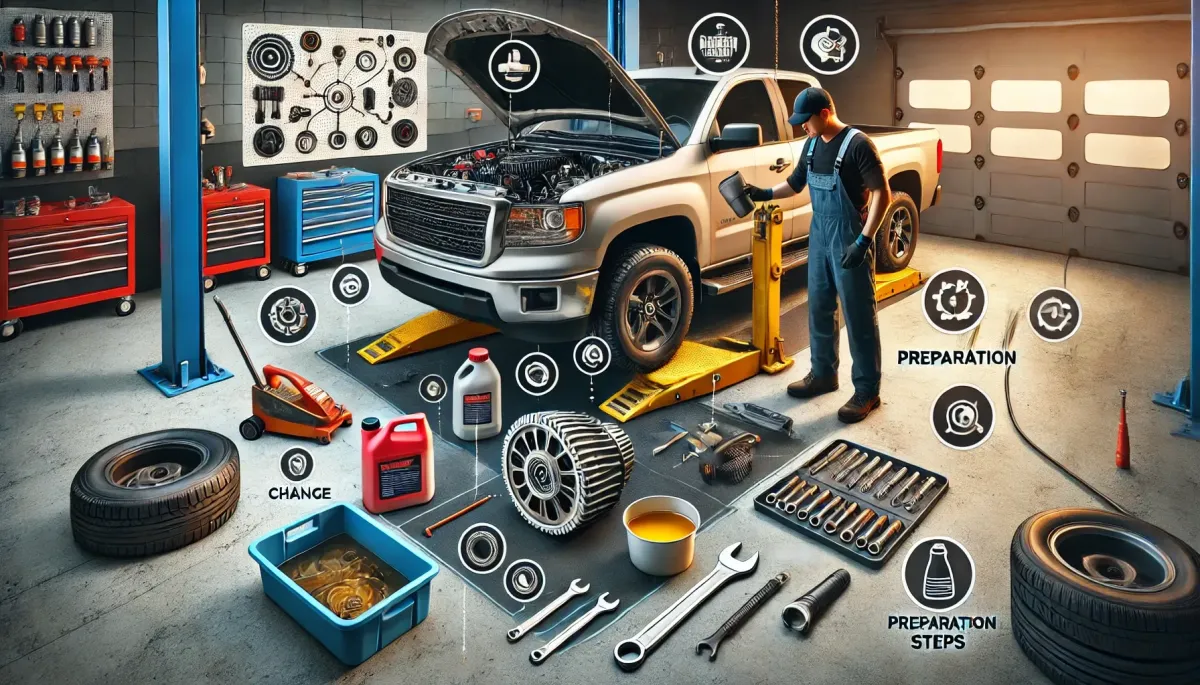
DIY Transmission Fluid Change: Step-by-Step Guide for Pickup Truck Owners
DIY Transmission Fluid Change: Step-by-Step Guide for Pickup Truck Owners
Changing your transmission fluid is one of the most essential maintenance tasks for ensuring the longevity and performance of your pickup truck. It’s a task that can be done at home with the right tools and knowledge, saving you money and giving you the satisfaction of doing it yourself. Imagine the confidence you'll gain from knowing your transmission is filled with fresh fluid, ready for any challenge. This chapter provides a detailed, step-by-step guide to changing your transmission fluid, making the process simple and accessible for all truck owners.
Key Points:
Why Regular Transmission Fluid Changes Are Important:
Maintaining Optimal Performance
Preventing Wear and Tear
Enhancing Longevity of the Transmission
Tools and Materials Needed:
Jack and Jack Stands
Wrench Set
Drain Pan
Transmission Fluid Pump
Funnel
Replacement Transmission Fluid
New Transmission Filter (if needed)
Gloves and Safety Glasses
Preparation Steps:
Park Your Truck on a Level Surface
Gather All Tools and Materials
Consult Your Truck’s Manual for Specific Instructions
Step-by-Step Fluid Change Process:
Draining the Old Transmission Fluid
Removing and Replacing the Transmission Filter
Cleaning the Transmission Pan and Magnet
Installing the Transmission Pan and Refilling with New Fluid
Checking Fluid Levels and Ensuring Proper Function
Real-World Examples:
Regular Fluid Changes:
Jake noticed smoother shifts and improved fuel efficiency after regularly changing his transmission fluid.
Sarah extended the life of her truck’s transmission by adhering to a consistent fluid change schedule.
Preparation:
Tom saved time by gathering all his tools and materials in advance, ensuring a smooth fluid change process.
Emily consulted her truck’s manual for the correct type of fluid, avoiding potential compatibility issues.
Fluid Change Process:
Frank successfully changed his transmission fluid by following a step-by-step guide, preventing potential transmission problems.
Lisa found and replaced a clogged filter during her fluid change, significantly improving her truck’s performance.
In-Depth Analysis:
Why Regular Transmission Fluid Changes Are Important:
Optimal Performance: Fresh transmission fluid ensures smooth gear shifts and efficient power transfer.
Preventing Wear: Regular fluid changes prevent buildup of contaminants that can cause wear on transmission components.
Longevity: Keeping the transmission fluid clean and fresh extends the life of the transmission, reducing the likelihood of costly repairs.
Tools and Materials Needed:
Jack and Jack Stands: Essential for safely lifting and supporting your truck.
Wrench Set: Needed for removing the drain plug and transmission pan bolts.
Drain Pan: Used to catch old transmission fluid as it drains.
Fluid Pump: Helps in adding new transmission fluid efficiently.
Funnel: Ensures accurate and spill-free refilling of transmission fluid.
Replacement Fluid and Filter: Always use the manufacturer-recommended fluid and consider replacing the filter if it’s time.
Preparation Steps:
Level Surface: Ensure your truck is parked on a level surface to get an accurate fluid reading.
Gather Tools: Have all necessary tools and materials ready before you start.
Consult Manual: Your truck’s manual provides vital information on the type and amount of fluid needed, as well as specific procedures.
Step-by-Step Fluid Change Process:
Draining Fluid:
Warm up the engine to ensure fluid flows easily.
Jack up the truck and secure it with jack stands.
Place the drain pan under the transmission and remove the drain plug, allowing fluid to drain completely.
Replacing Filter:
Remove the transmission pan bolts and the pan.
Carefully remove the old filter and replace it with a new one.
Cleaning Pan and Magnet:
Clean the transmission pan and the magnet inside, removing any metal shavings or debris.
Refilling Fluid:
Reinstall the transmission pan and tighten the bolts to the specified torque.
Use a funnel and fluid pump to add the new transmission fluid.
Check fluid levels using the dipstick and add more fluid if necessary.
Checking Function:
Start the engine and let it run for a few minutes.
Shift through all gears to circulate the new fluid.
Check for leaks and ensure the fluid level is correct.
Practical Applications:
Step-by-Step Guide:
Preparation: Park on a level surface, gather tools, and consult the manual.
Draining Fluid: Warm up the engine, lift the truck, and drain old fluid.
Filter Replacement: Remove the pan, replace the filter, and clean the pan.
Refilling Fluid: Reinstall the pan, add new fluid, and check levels.
Tool Recommendations:
Fluid Pump: Facilitates adding new fluid efficiently.
Torque Wrench: Ensures bolts are tightened to the correct specifications.
Safety Gear: Gloves and safety glasses protect against spills and debris.
Tips and Tricks:
Warm Engine: Ensures fluid flows easily and drains completely.
Clean Workspace: Keep the area clean to avoid contaminating new fluid.
Monitor Performance: Check for leaks and monitor the transmission’s performance after the fluid change.
Conclusion:
Changing your transmission fluid is a vital maintenance task that can be done at home with the right tools and knowledge. By following a systematic approach and adhering to manufacturer guidelines, you can ensure your transmission remains in top condition, enhancing your truck’s performance and longevity.
Call to Action:
Have you changed your pickup truck’s transmission fluid yourself? Share your experiences, challenges, and tips in the comments below. Let’s help each other master this essential maintenance task and keep our trucks running smoothly. Your insights could inspire and assist fellow truck owners looking to take control of their vehicle maintenance!
Ready to experience the TTS difference?
Visit prebuilttrans.com to learn more about our services or to schedule an appointment or call +1 385-462-8458 for more info! We're dedicated to keeping your pick-up truck running in tip-top shape!
Disclaimer: This blog post is intended for informational purposes only and should not be interpreted as professional advice. Always consult with a qualified mechanic or transmission specialist for specific recommendations regarding your vehicle.
© 2024 Truck Transmission Specialists. All rights reserved.

